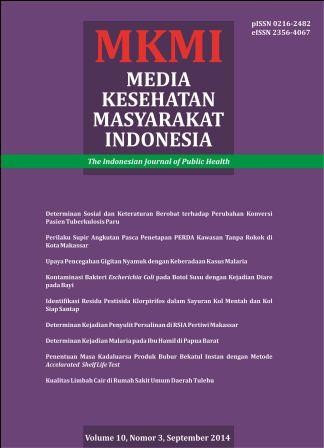DETERMINAN KEJADIAN PENYULIT PERSALINAN DI RSIA PERTIWI MAKASSAR
Abstract
Tingginya angka kematian ibu di Indonesia sebagian besar disebabkan oleh timbulnya penyulit persalinan yang tidak dapat segera dirujuk ke fasilitas pelayanan kesehatan yang lebih mampu. Penelitian ini bertujuan mengetahui hubungan keterlambatan dengan kejadian penyulit persalinan. Jenis penelitian ini adalah observasional analitik dengan rancangan penelitian kasus kontrol. Besar sampel sebanyak 30 kasus, yaitu ibu yang mengalami penyulit persalinan dan 90 kontrol yang tidak mengalami penyulit persalinan yang diambil dengan cara consequtive sampling. Analisis data dilakukan uji chi square, odds ratio dan metode regresi logistik berganda. Hasil penelitian menunjukkan risiko mengalami penyulit persalinan pada ibu yang mengalami keterlambatan dalam mencapai fasilitas kesehatan 3,1 kali lebih besar dibandingkan ibu yang tidak mengalami keterlambatan (OR=3,1; 95% CI:1,30-7,14), dan risiko mengalami penyulit persalinan pada ibu yang mengalami keterlambatan dalam mendapatkan pertolongan medis 6,5 kali lebih besar dibandingkan yang tidak mengalami keterlambatan (OR=6,54; 95% CI:1,76-24,29). Disarankan bagi anggota keluarga dan masyarakat untuk dapat mengenali secara dini tanda-tanda terjadinya komplikasi selama kehamilan, persalinan dan nifas sehingga komplikasi dapat segera ditangani oleh petugas kesehatan dan mencegah terjadinya keterlambatan rujukan.
Full text article
References
Rusydi, S. Partus Kasep Di RSUP Palembang Selama 5 Tahun.Jurnal Kedokteran dan Kesehatan UNSRI. 2010; 37 (2).
WHO. Maternal Mortality in 2000. Department Of Reproductive Health and Research. Geneva: World Health Organization; 2003.
Saifudin AB. Kematian Maternal. Dalam: Ilmu Kebidanan. Edisi Ketiga. Jakarta: Yayasan Bina Pustaka; 1994.
Depkes RI. Kajian Kematian Ibu dan Anak di Indonesia. Badan Penelitian dan Pengembangan Kesehatan. Jakarta: Depkes RI; 2004.
UNFPA. Maternal Mortality Update 2002, A Focus On Emergency Obstetric Care. New York: UNFPA; 2003.
Stekelenburg, J. et al. Waiting Too Long: Low Use Of Maternal Health Services In Kalabo, Zambia. Tropical Medicine & International Health. 2004; 9 (3):390-398.
Thaddeus, S. And Maine, D. Too Far To Walk: Maternal Mortality In Context, Social Science &Medicine (1982). 1994;38 (8): 1091-1110.
Mills, S. et al. 2007. HNP Discussion Paper “Obstetric Care In Poor Settings In Ghana, India, And Kenya”, The World Bank. [Online]
http:// Siteresources.Worldbank.Org/EXTBNPP/ Resources/TF053528MillsObstetricCare.Pdf Diakses 2 Desember 2011
Kiguli, J. Increasing Access To Quality Health Care For The Poor: Community Perceptions On Quality Care In Uganda, Dove Medicalpress Ltd. 2008 : 77-88.
Graham, W. Can Skilled Attendance At Delivery Reduce Maternal Mortality In Developing Countries?. Safe Motherhood Strategies: A Reviewof The Evidence, 2001; 17:97-130. [Online] [Diakses 2 Desember 2011]. Available at : http://www.modirisk.be/.
Duffy, S. Obstetric Hemorrhage In Gambi, Ethiopia: The Obstetrician & Gynecologist. 2007;9 (2): 121-126.
Kamwendo, LA & Bullough., C.Insight On Skilled Attendance At Birth In Malawi-The Findings Of A Structured Document And Literature Review. Malawi Medjournal. 2005; 16(2):40-42.
Africa Union. 2009. Theme: Universal Access to Quality Health Services Improve Maternal, Neonate And Child Healt [Online] [Diakses 2 Desember 2011]. Available at : http://www.africaunion.Org/Root/UA/Conferences/2009/Mai/SA/04-08mai/.
MacDonagh, S. 2005. Achieving Skilled Attendance For all: A Synthesis Of Current Knowledge And Recommended Actions For Scaling Up. DFID Health Resource Centre. [Online] [Diakses 3 Desember 2011]. Available at : http://www.Expandnet.Net/Pdfs/Skilled-Attendance-Report.Pdf.
Canavane. 2008. Review Of Global Literature On Maternal Health Interventions And Outcomes Related To Provision Of Skilled Birth Attendance. Development Policy Practice KIT, Mauritskade 63, 1092 AD Amsterdam. [Online] [Diakses 2 Desember 2011]. Available at : http://Kit.Nl/Net/ KIT_Publicaties_Output/.
Harvey, S. et al. Are Skilled Birth Attendants Really Skilled?A Measurement Method, Some Disturbing Results And A Potential Way Forward, Bulletin Of The World Health Organization. 2007;85(10) : 783-790.
Authors
Authors retain copyright and grant the journal right of first publication with the work simultaneously licensed under a Creative Commons Atribusi-NonKomersial-BerbagiSerupa 4.0 Internasional License that allows others to share the work with an acknowledgement of the work's authorship and initial publication in this journal.
Copyright encompasses rights to reproduce and deliver the article in all form and media, including reprints, photographs, microfilms and any other similar reproductions, as well as translations. The reproduction of any part of this journal, its storage in databases and its transmission by any form or media, such as electronic, electrostatic and mechanical copies, photocopies, recordings, magnetic media, etc.
All articles published Open Access are free for everyone to read and download. Under the CC-BY-NC-SA license, authors retain ownership of the copyright for their article, but authors grant others permission to use the content of publications in Media Kesehatan Masyarakat Indonesia Universitas Hasanuddin in whole or in part provided that the original work is properly cited. Users (redistributors) of Media Kesehatan Masyarakat Indonesia Universitas Hasanuddin are required to cite the original source, including the author's names, Media Kesehatan Masyarakat Indonesia Universitas Hasanuddin as the initial source of publication, year of publication, and volume number.
Media Kesehatan Masyarakat Indonesia Universitas Hasanuddin is licensed under Creative Commons Atribusi-NonKomersial-BerbagiSerupa 4.0 Internasional.


